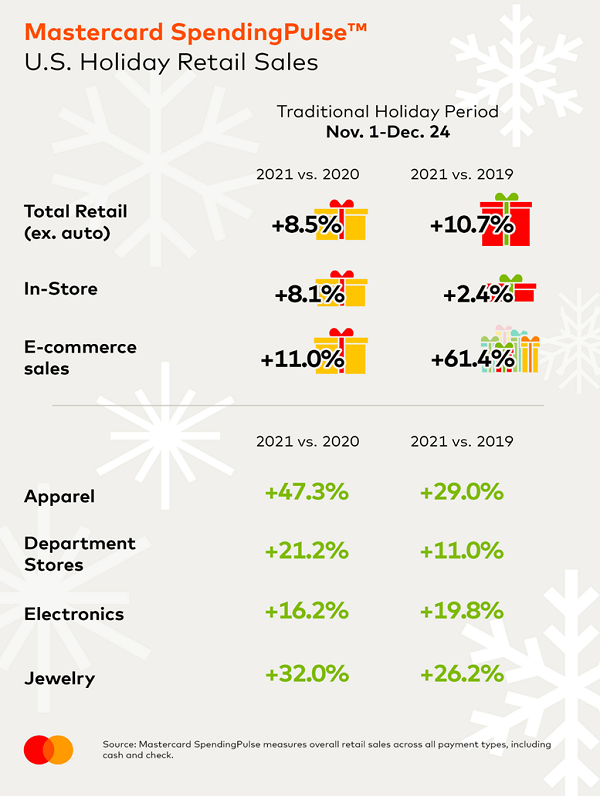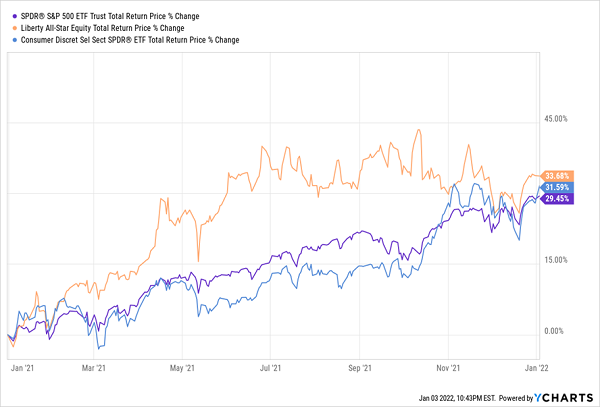Here’s my best advice as 2022 dawns: ignore the media’s constant bleating about inflation and supply-chain issues—these two boogeymen are nowhere near the threats everyone thinks they are!
In fact, terror-ridden headlines about either mark an opportunity for us contrarian income-seekers. So let’s go ahead and tap these investor fears for dividends yielding up to 10%, plus market-crushing returns as the crowd (inevitably!) comes around to our view.
Hints of a Supply-Chain Revival
More data will come in over the next few weeks to make things clearer, but so far there is one strong hint that the business press’s doomsday scenario—surging inflation, a stock-market correction and tighter corporate profits—just isn’t on.
That’s because the pundits are overlooking the fact that the supply chain is in the earliest stages of healing. The proof is in a little-noticed report from Mastercard (MA) on holiday-season spending.

There’s a lot to unpack in this chart, but the total retail numbers are the key here. Compared to the end of 2020, shoppers increased their spending by 8.5%. More importantly, they increased their spending by 10.7% compared to the pre-pandemic year of 2019.
The key takeaway is that supply-chain issues are clearly not stopping consumers from buying goods. Despite seemingly endless stories of empty shelves, shoppers had no problem finding what they wanted to buy—in abundance!
So who benefits from easing supply-chain worries? Easy: big US retailers such as Home Depot (HD), Best Buy (BBY) and Walmart (WMT). In other words, the same large cap stocks that gave investors great returns in 2021.
Most folks would look to play an emerging trend like this by purchasing these stocks directly or through an ETF like the Consumer Discretionary ETF (XLY). But we’re closed-end fund (CEF) buyers first and foremost, and for a very good reason: CEFs pay huge dividends! The average yield across all CEFs is hovering around 7% as I write this.
That’s why we’re going to skip XLY and its 0.5% yield and look to a CEF like the Liberty All-Star Equity Fund (USA), which holds a number of stocks poised to profit from the freer flow of goods, including Amazon.com (AMZN), PayPal Holdings (PYPL) and Visa (V).
It’s a solid performer, too, topping both XLY (in blue below) and the major S&P 500 index fund (in purple) by total return last year. And USA did so while paying an almost-unheard-of 10% yield! In other words, about a third of the return you see from this fund below was in safe dividend cash.
“All-Star” CEF Routs Its Benchmarks—While Yielding 10%

Skeptical of a 2022 Stock Surge? This CEF Is for You
There’s a flipside to those gains, though: with both funds beating the S&P 500, you may think the trend toward higher consumer spending in 2022 is already priced in.
I don’t agree with that take, but if this is your view, you could consider the ultra-diversified Nuveen S&P 500 Dynamic Overwrite Fund (SPXX), which holds the entirety of the S&P 500, so you get access to consumer stocks and the index’s other sectors, too, such as financial services, healthcare, technology, real estate and industrials.
The twist here is that SPXX sells call options on its holdings, a savvy move that boosts your income and helps hedge your investment against a downturn.
Here’s how it works: the call options SPXX sells are contracts, under which the fund sells the right to buy its stocks to another investor at a fixed share price in exchange for a cash payment, known as a premium. This gives the seller protection from a downturn, since they get to keep the premium no matter what happens, and the option expires if the stock does go down.
This means SPXX carries less risk than an index fund or individual stocks while providing an additional income stream the fund can pass on to you. This is why SPXX’s dividend yields 5.3%, more than four times the S&P 500’s average yield of 1.3%.
4 MORE Top Income Picks for 2022 (With 7.5% Dividends, 20% Gains on Tap)
The beauty of the CEF market is that it’s small (with just 500 or so funds in existence). That means it’s mostly individual investors, rather than institutional players, who buy these funds. And that means there are mispriced deals available to us on the regular—even in a pricey market like today’s.
The 4 CEFs I’ve set aside for you right here are prime examples. They yield an outsized 7.5%, on average, today, and they all trade at ridiculous discounts. That won’t last, though, which is why I’m pounding the table on 20%+ price gains from these well-run income plays this year.
I’ve got full details on all 4 of these must-own CEFs waiting for you now, and I can’t wait to share them: Click here for full details, including these 4 funds’ names, tickers, current yields, best buy prices and more.
